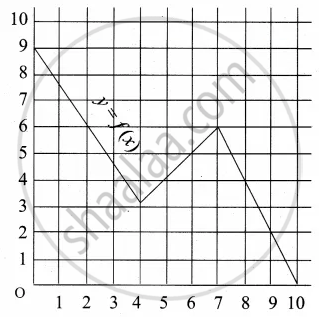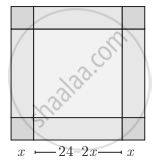Advertisements
Advertisements
Question
If \[y = f\left( x \right) = \frac{ax - b}{bx - a}\] , show that x = f(y).
Solution
Given:
⇒ y( bx -a) = ax – b
⇒ xyb – ay = ax – b
⇒ xyb – ax = ay – b
⇒ x(by – a) = ay – b
Hence proved.
APPEARS IN
RELATED QUESTIONS
Find the domain of the function f(x) = `(x^2 + 2x + 1)/(x^2 - 8x + 12)`
find: f(1), f(−1), f(0) and f(2).
A function f : R → R is defined by f(x) = x2. Determine (a) range of f, (b) {x : f(x) = 4}, (c) [y: f(y) = −1].
f, g, h are three function defined from R to R as follow:
(iii) h(x) = x2 + 1
Find the range of function.
et A = (12, 13, 14, 15, 16, 17) and f : A → Z be a function given by
f(x) = highest prime factor of x.
Find range of f.
If \[f\left( x \right) = \frac{2x}{1 + x^2}\] , show that f(tan θ) = sin 2θ.
If f, g and h are real functions defined by
Write the range of the function f(x) = cos [x], where \[\frac{- \pi}{2} < x < \frac{\pi}{2}\] .
Let A = {1, 2, 3} and B = {2, 3, 4}. Then which of the following is a function from A to B?
If x ≠ 1 and \[f\left( x \right) = \frac{x + 1}{x - 1}\] is a real function, then f(f(f(2))) is
Let f(x) = x, \[g\left( x \right) = \frac{1}{x}\] and h(x) = f(x) g(x). Then, h(x) = 1
Let A = {x ∈ R : x ≠ 0, −4 ≤ x ≤ 4} and f : A ∈ R be defined by \[f\left( x \right) = \frac{\left| x \right|}{x}\] for x ∈ A. Then th (is
f is a real valued function given by \[f\left( x \right) = 27 x^3 + \frac{1}{x^3}\] and α, β are roots of \[3x + \frac{1}{x} = 12\] . Then,
If f(x) = sin [π2] x + sin [−π]2 x, where [x] denotes the greatest integer less than or equal to x, then
The domain of definition of \[f\left( x \right) = \sqrt{\frac{x + 3}{\left( 2 - x \right) \left( x - 5 \right)}}\] is
The range of the function \[f\left( x \right) = \frac{x + 2}{\left| x + 2 \right|}\],x ≠ −2 is
Let \[f\left( x \right) = \sqrt{x^2 + 1}\ ] . Then, which of the following is correct?
If f(x) = `{(x^2 + 3"," x ≤ 2),(5x + 7"," x > 2):},` then find f(0)
Which sets of ordered pairs represent functions from A = {1, 2, 3, 4} to B = {−1, 0, 1, 2, 3}? Justify.
{(1, 2), (2, −1), (3, 1), (4, 3)}
Check if the relation given by the equation represents y as function of x:
x2 − y = 25
Find x, if g(x) = 0 where g(x) = 6x2 + x − 2
Find the domain and range of the follwoing function.
h(x) = `sqrt(x + 5)/(5 + x)`
An open box is made from a square of cardboard of 30 cms side, by cutting squares of length x centimeters from each corner and folding the sides up. Express the volume of the box as a function of x. Also find its domain
Check the injectivity and surjectivity of the following function.
f : Z → Z given by f(x) = x2
Express the following logarithmic equation in exponential form
log10 (0.001) = −3
Solve for x.
2 log10 x = `1 + log_10 (x + 11/10)`
Answer the following:
Identify the following relation is the function? If it is a function determine its domain and range.
{(0, 0), (1, 1), (1, –1), (4, 2), (4, –2), (9, 3), (9, –3), (16, 4), (16, –4)}
Answer the following:
If `log"a"/(x + y - 2z) = log"b"/(y + z - 2x) = log"c"/(z + x - 2y)`, show that abc = 1
Answer the following:
Find the range of the following function.
f(x) = `1/(1 + sqrt(x))`
A graph representing the function f(x) is given in it is clear that f(9) = 2

Describe the following Domain
An open box is to be made from a square piece of material, 24 cm on a side, by cutting equal square from the corner and turning up the side as shown. Express the volume V of the box as a function of x

The domain of the real valued function f(x) = `sqrt((x - 2)/(3 - x))` is ______.
Find the domain for which the functions f(x) = 2x2 – 1 and g(x) = 1 – 3x are equal.
Find the range of the following functions given by `sqrt(16 - x^2)`
Find the range of the following functions given by f(x) = `3/(2 - x^2)`
Find the range of the following functions given by f(x) = 1 + 3 cos2x
(Hint: –1 ≤ cos 2x ≤ 1 ⇒ –3 ≤ 3 cos 2x ≤ 3 ⇒ –2 ≤ 1 + 3cos 2x ≤ 4)
If f(x) = `(x - 1)/(x + 1)`, then show that `f(- 1/x) = (-1)/(f(x))`
Which of the following functions is NOT one-one?
